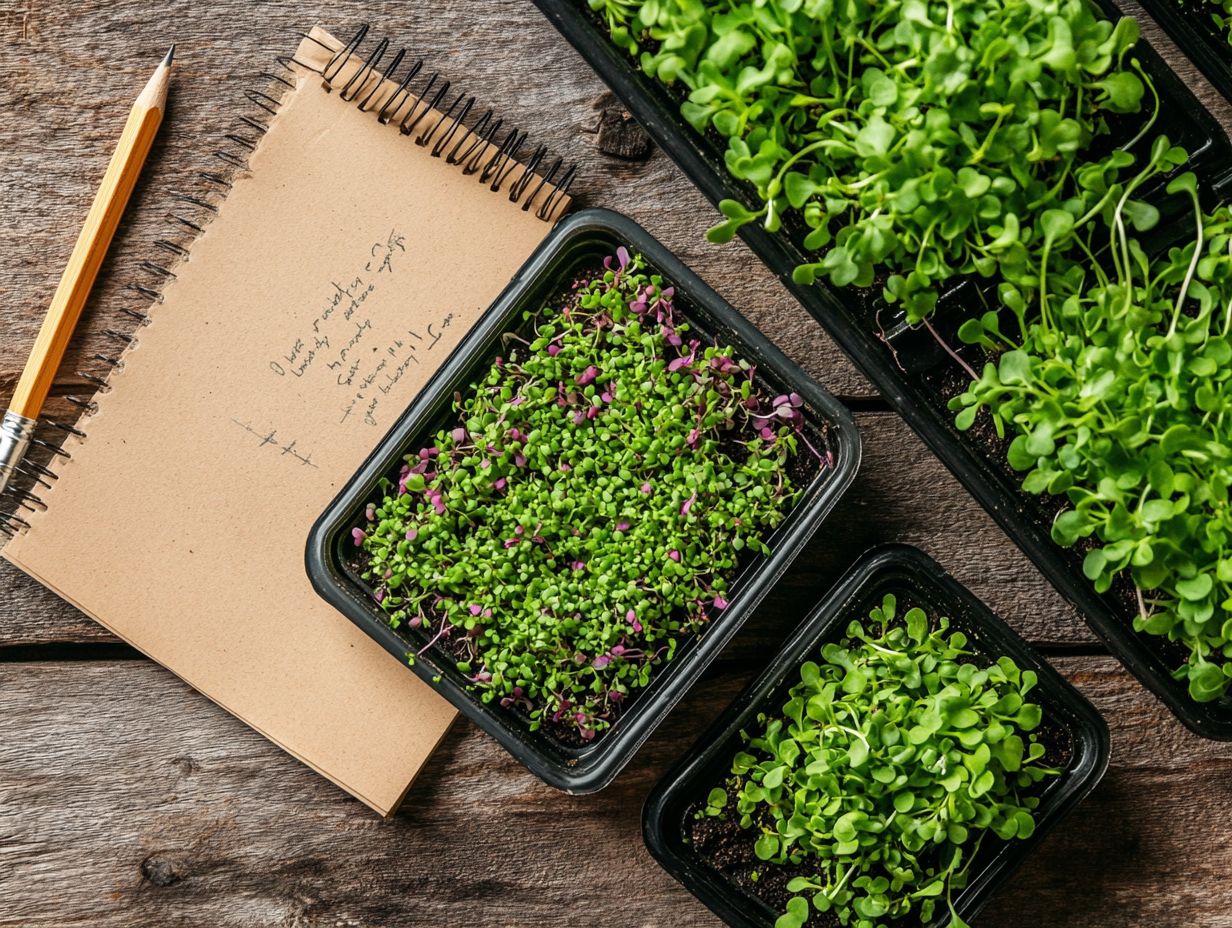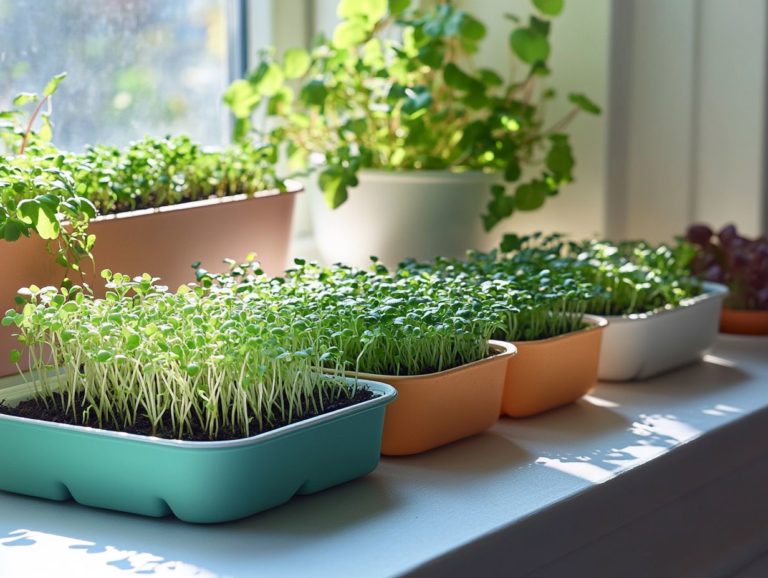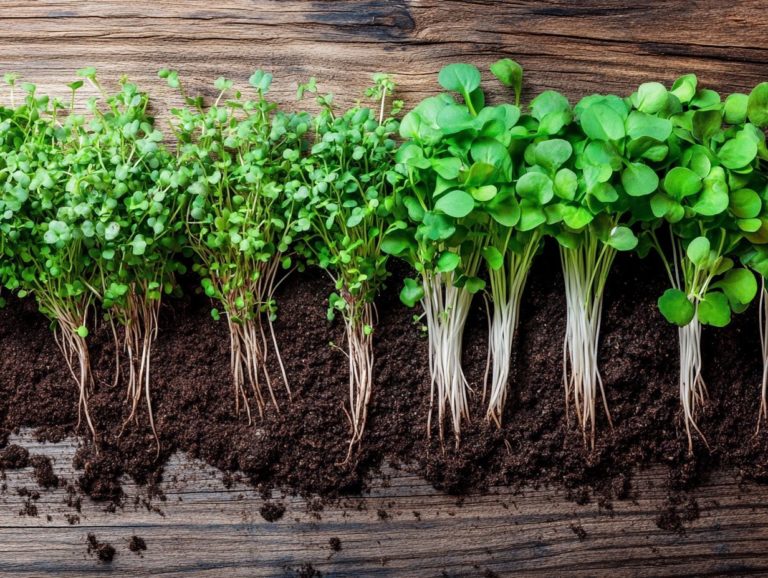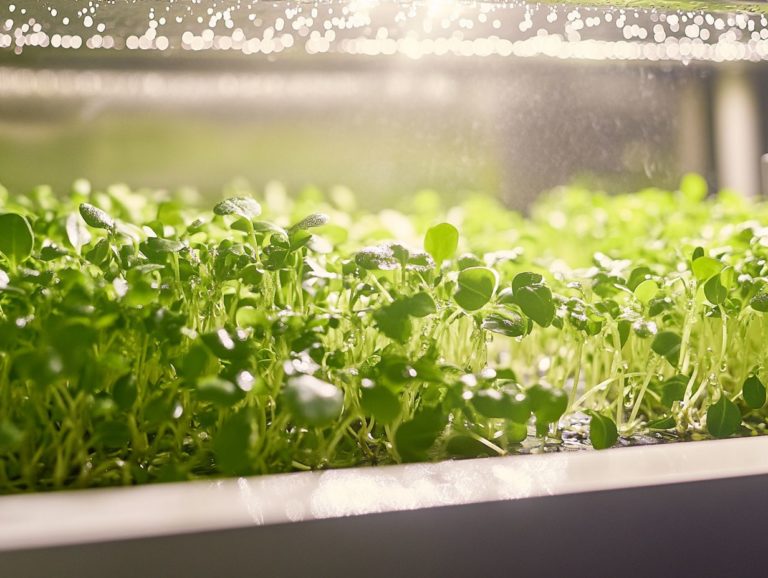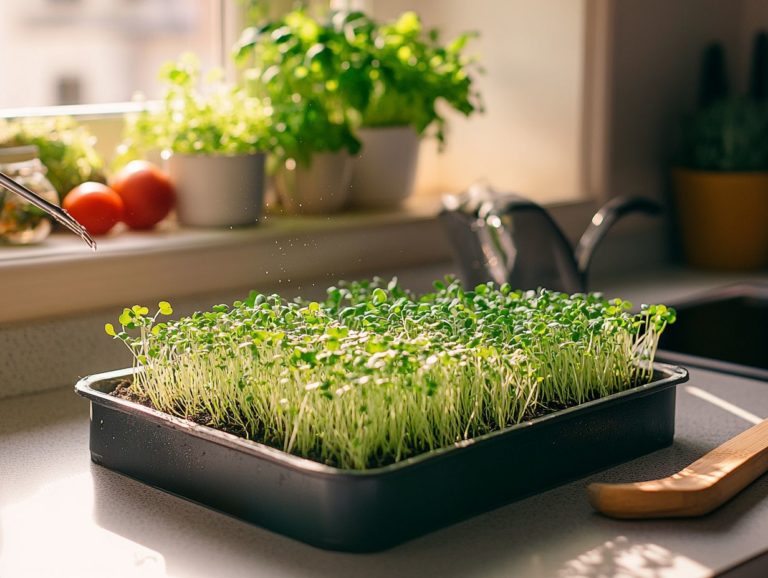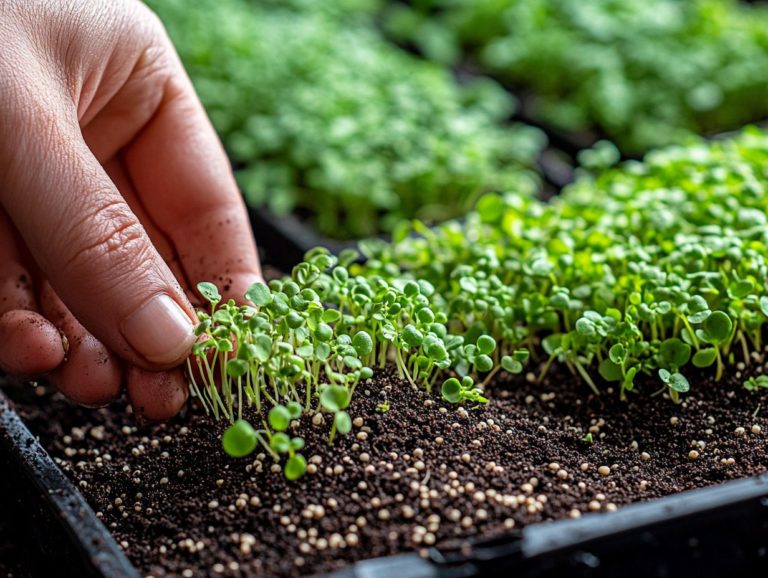Creating a Microgreen Growth Diary
Microgreens have emerged as a favored choice among home gardeners and culinary enthusiasts, delivering a delightful burst of flavor and nutrition in a compact package.
This guide delves into everything you need to know about microgreens, a type of edible plant used in home gardening from their definition and the various types available to the numerous benefits of cultivating them.
You will discover how to establish and maintain a microgreen growth diary, learn best practices for harvesting, and explore delicious recipes to seamlessly incorporate them into your meals.
We will also cover common challenges to ensure your success with microgreens.
Jump in and discover how these tiny greens can boost your health and transform your meals into culinary masterpieces!
Contents
- Key Takeaways:
- What are Microgreens?
- Benefits of Growing Microgreens
- Creating a Microgreen Growth Diary
- Harvesting and Using Microgreens
- Troubleshooting Common Issues
- Frequently Asked Questions
- What is a microgreen growth diary?
- Why should I create a microgreen growth diary?
- What information should I include in my microgreen growth diary?
- How often should I update my microgreen growth diary?
- Can I use a digital or online diary to track my microgreen growth?
- Are there any resources or templates available for creating a microgreen growth diary?
Key Takeaways:
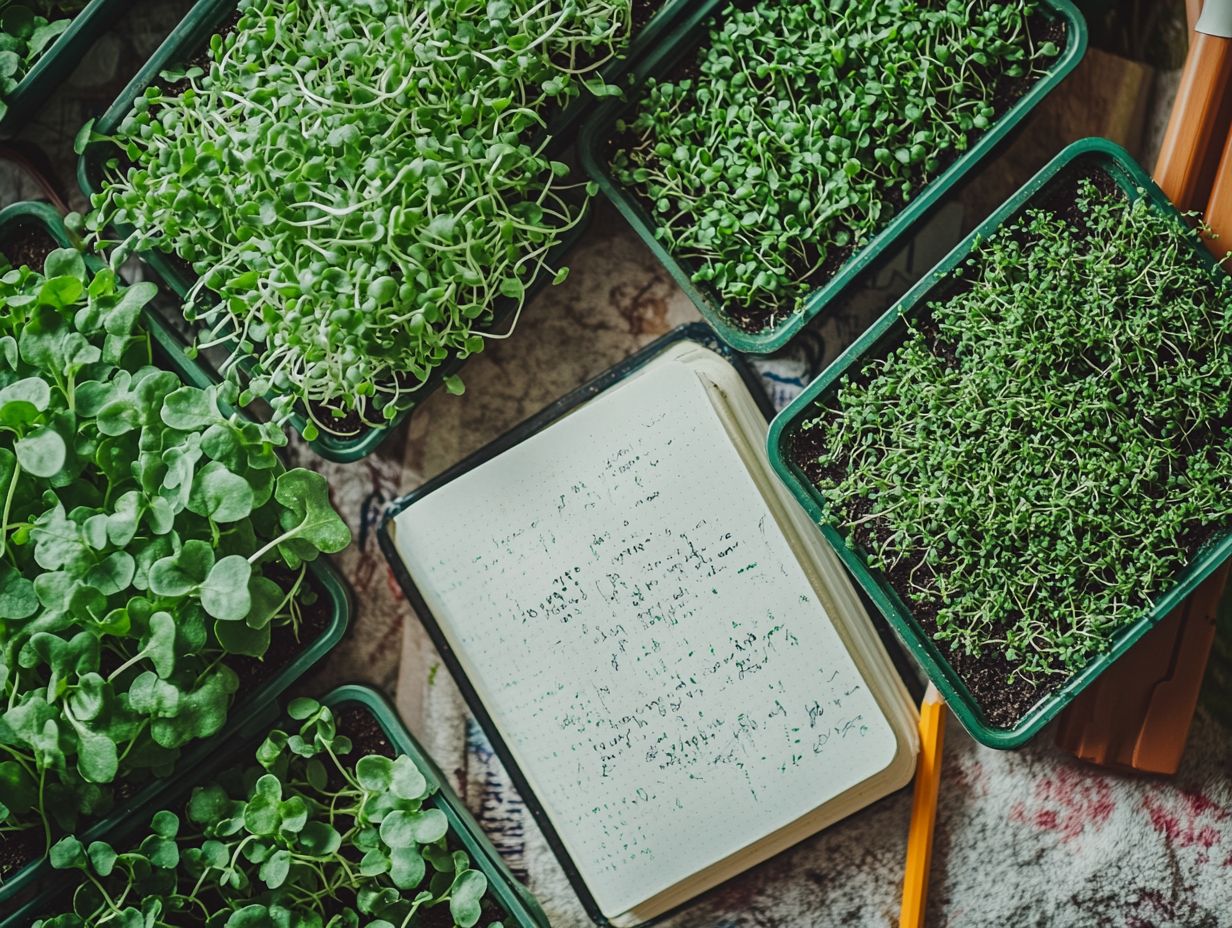
- Keep track of your microgreen growth with a diary to ensure successful and consistent results.
- Growing your own microgreens not only provides nutritional benefits but also saves you money in the long run.
- Regular maintenance and harvesting practices, along with troubleshooting potential issues, are crucial for a successful microgreen growth diary.
What are Microgreens?
Microgreens are young, edible greens that you can harvest just after the first set of real leaves appear. They offer a concentrated burst of nutrients and flavor that is simply unmatched.
You can grow them from a variety of seeds, including those from vegetables and herbs like broccoli, arugula, and pea shoots, making them a wonderfully versatile addition to your home gardening setup.
Their vibrant colors and intense flavors not only elevate your dishes but also deliver a wealth of health benefits, packed with high levels of vitamins and minerals essential for maintaining your overall well-being.
Definition and Types
Microgreens are the young seedlings of edible vegetables and herbs, harvested at a tender stage of growth, typically between 7 to 21 days after germination.
These vibrant little plants don’t just add a splash of color; they also deliver a rich array of nutrients. Some popular choices include:
- Broccoli, renowned for its cancer-fighting properties.
- Arugula, which lends a zesty, peppery kick to your culinary creations.
- Tender pea shoots, bringing a sweet, garden-fresh flavor to the table.
To cultivate these microgreens at home, you’ll need a well-draining soil mix, plenty of light—whether from natural sunlight or grow lights—and consistent moisture. For those interested in getting started, check out this guide on how to create a microgreen grow kit. Using shallow trays simplifies the harvesting process and speeds up your turnaround time.
Each type of microgreen comes with its own unique advantages, and knowing how to create a microgreen storage schedule can help maximize their benefits:
- Broccoli microgreens are loaded with sulforaphane, a compound known for its health benefits.
- Arugula boasts a high vitamin K content, essential for bone health.
- Pea shoots are an excellent source of vitamins A and C, making them delightful additions to salads, sandwiches, or as eye-catching garnishes.
Benefits of Growing Microgreens
Growing microgreens presents a wealth of benefits for you. Not only are they packed with nutrients that contribute to your health, but they also offer cost savings, as you can easily cultivate them at home.
Imagine having a continuous supply of fresh vegetables, right at your fingertips, whether from your kitchen windowsill or your indoor garden.
Start your journey with microgreens today for fresh, nutritious meals!
Nutritional Value and Cost Savings
Microgreens are not just a burst of flavor; they also pack an impressive nutritional punch. They often have higher levels of essential vitamins and minerals, such as potassium, iron, and zinc, than mature vegetables.
Take broccoli and radish microgreens, for instance; they can boast up to 40 times more phytonutrients than mature vegetables. Their compact size and rapid growth cycle make them an ideal solution for those looking to elevate their diets. If you’re interested in cultivating a variety of these nutritious plants, check out this guide on how to create a microgreen variety garden without requiring extensive garden space.
While you may encounter a premium price tag at local markets, the financial advantages of cultivating microgreens at home soon become clear. With just a few basic supplies and some seeds, you can significantly reduce your grocery bills over time, all while enjoying a steady supply of fresh, nutrient-dense greens right from your kitchen windowsill. To maximize your success, it’s helpful to understand the growth cycles of microgreens.
Creating a Microgreen Growth Diary
Creating a microgreen growth diary is an exceptional method for you to document the progress of your indoor gardening endeavors. This diary helps you track seed germination and soil moisture. You can also assess light conditions and other factors for optimal plant growth.
Supplies and Setup
To successfully grow microgreens, you ll need a few essential supplies: growing trays, a suitable growing medium (the material in which plants grow, such as soil or hydroponic systems), and basic garden tools to facilitate the planting and maintenance process.
These supplies ensure optimal growth and enhance your gardening experience. Growing trays, for instance, come in various sizes and materials, providing the perfect environment for germination while allowing for easy drainage. If you’re interested in maximizing your microgreens, consider using sprouting trays for microgreens.
A quality growing medium, whether it’s nutrient-rich soil or a hydroponic system, plays a crucial role in delivering the necessary nutrients to your microgreens. Understanding the science behind microgreen growth can further enhance your gardening skills. Essential garden tools, like spray bottles for gentle watering and scissors for harvesting, will help you maintain the health of your microgreens and make the growing process far more enjoyable.
Daily Tracking and Maintenance
Daily tracking and maintenance of your microgreens require a keen eye and attentive care. This means monitoring soil moisture levels, ensuring appropriate watering, and adjusting light conditions to foster robust growth.
To keep your microgreens thriving, it’s vital to master the art of checking soil moisture. Simply press your finger gently into the soil; if it feels dry a couple of inches down, it’s time to give them a drink. Watering wisely is equally important always choose gentle misting or pour water at the base of the plants to avoid disturbing those delicate seedlings.
Consistency in light exposure is key. Aim for about 12-16 hours of light each day.
Maintaining a detailed journal of your daily activities from watering schedules to shifts in growth patterns will not only enrich your gardening experience but also equip you to tackle any issues that may arise. For those interested in growing microgreens, following a step-by-step guide to sowing microgreens can be particularly helpful.
Harvesting and Using Microgreens
Harvesting microgreens is a fun and rewarding process that boosts both flavor and nutrition.
Master these practices and you’ll easily add these vibrant greens to all your favorite dishes, taking your culinary skills to the next level!
Best Practices and Recipes
Implementing best practices for harvesting microgreens allows you to savor their maximum flavor and health benefits. This enhances a variety of recipes that elevate your meals.
Use the right cutting techniques. Snip the greens just above the soil line with clean scissors or a sharp knife to preserve their delicate structure and vibrant taste.
For storage, keep your harvested microgreens in a breathable container. To learn more about growing microgreens, check out how to start a microgreen garden for beginners. Place it in a cool, dark location to maintain freshness for several days.
In the kitchen, these tiny powerhouses can seamlessly enhance your everyday dishes. Imagine adding a handful to your sandwiches, tossing them into salads, or using them as a vibrant garnish on soups and omelets. To achieve the best results, consider using essential tools for microgreen growing success. Such simple additions can significantly elevate both the flavor and nutritional profile of any meal.
Troubleshooting Common Issues
Troubleshooting common issues in growing microgreens is essential for your success. Factors like light conditions, soil moisture, and seed quality play pivotal roles in the overall health and yield of your plants.
Addressing these elements thoughtfully will help you grow healthy microgreens that meet your expectations.
Identifying and Addressing Problems
Identifying and addressing problems promptly is crucial in microgreen cultivation. Watch for signs like overwatering, inadequate light conditions, or pest infestations that can significantly hinder growth.
Keep an eye out for yellowing leaves, as this often indicates a nutrient deficiency or excessive moisture. This allows you to pinpoint issues early. If your microgreens show stunted growth or elongated stems, it’s likely they aren’t receiving enough light. For more insights, refer to understanding microgreen growth rates. These symptoms suggest that it may be time to adjust your watering routine or the placement of your grow lights.
By ensuring a balanced watering schedule and providing adequate lighting for at least 12-16 hours a day, you can greatly enhance their health and productivity.
For more information on growing microgreens, you can refer to resources from Francesco Di Gioia at Penn State.
Frequently Asked Questions
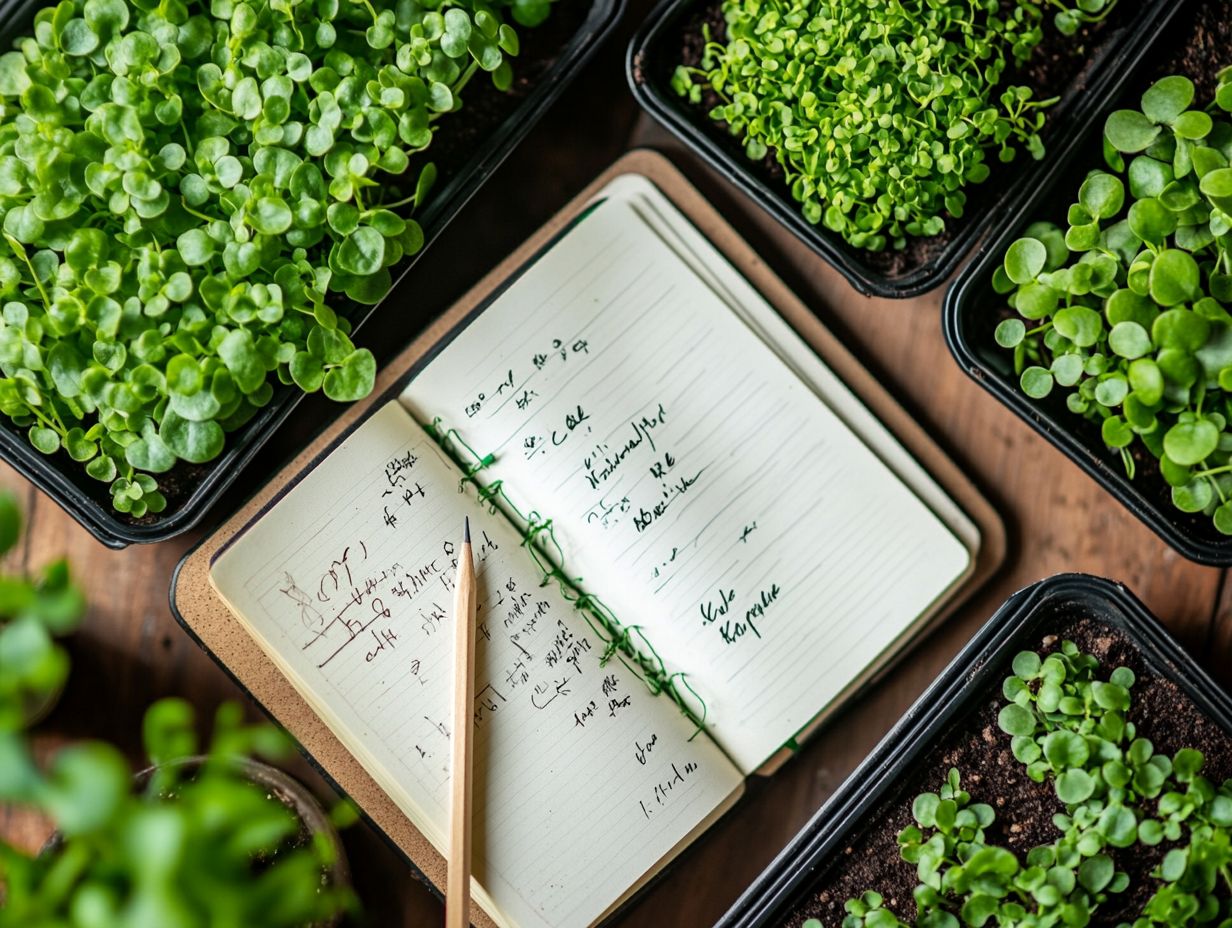
What is a microgreen growth diary?
A microgreen growth diary is a record-keeping tool used to track the growth and progress of microgreens. It typically includes information such as the date of sowing, growth milestones, and any observations made during the growth process.
Why should I create a microgreen growth diary?
A microgreen growth diary helps you keep an eye on your plants growth. You can spot problems early and make improvements for next time. It also serves as a helpful reference for future plantings.
What information should I include in my microgreen growth diary?
Some key pieces of information to include are the date of sowing, the type of microgreens planted, watering and lighting schedules, and any observations or notes about the growth process.
How often should I update my microgreen growth diary?
It is recommended to update your microgreen growth diary at least once a week to track the progress of your microgreens. However, you can also make more frequent updates if desired to closely monitor the growth process.
Can I use a digital or online diary to track my microgreen growth?
Yes, there are many digital or online diary options available for tracking your microgreen growth. These can be helpful for easy access and organization of your records.
Are there any resources or templates available for creating a microgreen growth diary?
Yes, there are plenty of resources and templates available online for creating a microgreen growth diary. You can also customize your own diary based on your specific needs and preferences.

